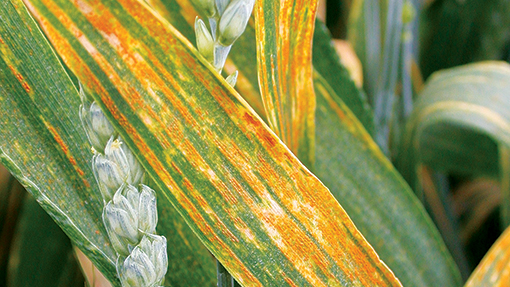Yellow rust on course for worst-ever season

The worst-ever season for yellow rust may be in prospect as high levels of an aggressive strain of the disease are being seen in winter wheat in eastern England.
The warning comes from Bill Clark, cereal disease expert at crop consultant NIAB TAG, who says some crops needed a fungicide before Christmas to suppress the disease.
He added that even varieties with a high yellow rust resistance score on the HGCA Recommended List were showing disease.
“These varieties are still susceptible at the seedling stage and the inoculum has established itself in the crop in the autumn,” said Mr Clark.
The yellow rust population is now dominated by the Warrior race, an aggressive strain named after a previously resistant variety on which it was discovered.
With a maximum score of 9 against the disease, the discovery of yellow rust spores on Warrior indicated to plant pathologists that they were dealing with a new strain.
“It probably came from China and those that think they know yellow rust could be in for a surprise. We may be heading into the worst yellow rust year ever,” warned Mr Clark at last week’s Association of Independent Crop Consultants annual conference.
Where the disease is present, he said a holding spray would be advisable if travelling was possible to keep levels down ahead of fungicide programmes starting in earnest.
He said only a long and sustained period of frost and low temperatures would have any meaningful control on the disease.
Faye Ritchie, plant pathologist at ADAS in Cambridgeshire, told Farmers Weekly there has been yellow rust, and also brown rust, in crops since before Christmas but advises that nothing needs to be done at the moment as cooler and frosty weather will give some control.
“Growers need to keep an eye on infected crops and, once warm weather returns, they may have to treat slightly earlier than the normal T0 March treatment,” she added.
David Ellerton, technical development director at distributor Hutchinsons, said yellow rust is widespread over a range of varieties in eastern England, and is also being seen further west and north.
“At the moment it is generally not spreading and it’s being seen on individual plants rather than across the whole crop,” he said.
His advice for treatment would be a fast-moving triazole such as tebuconazole or cyproconazole, but ideally growers should hold off if possible until a T0 spray in March.
Alison Daniels, fungicide expert at Bayer CropScience, explained yellow rust often looks worse pre-season and growers should focus on the risk of septoria, which is more difficult to control.
She added several consecutive days of temperatures below -5C will knock inoculum levels back.
“Only highly susceptible varieties on our yellow rust-prone Long Sutton trial site close to The Wash had infections last week. It’s visible to the levels you might expect following a mild winter but not unduly so, or as universally as septoria,” she said.
(More on yellow rust.)

